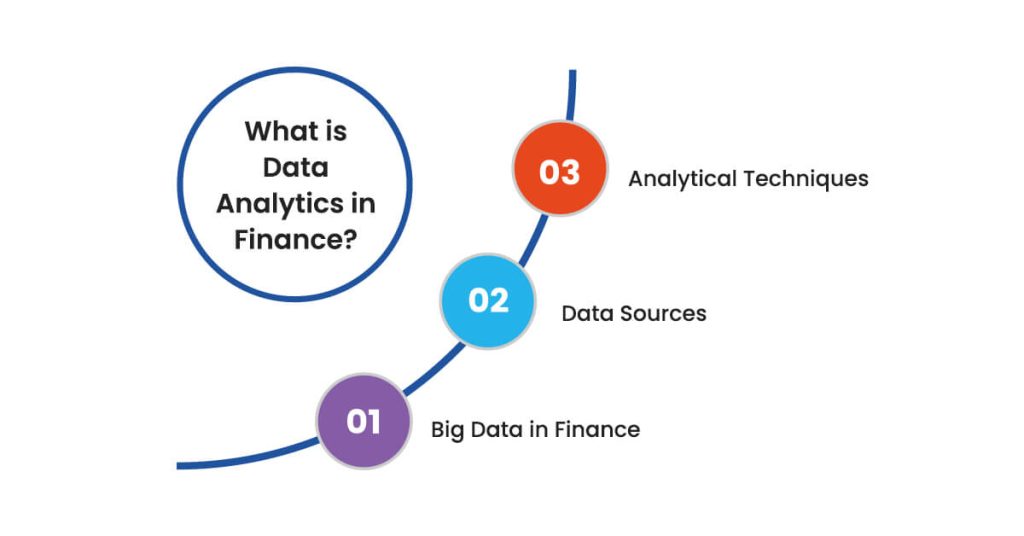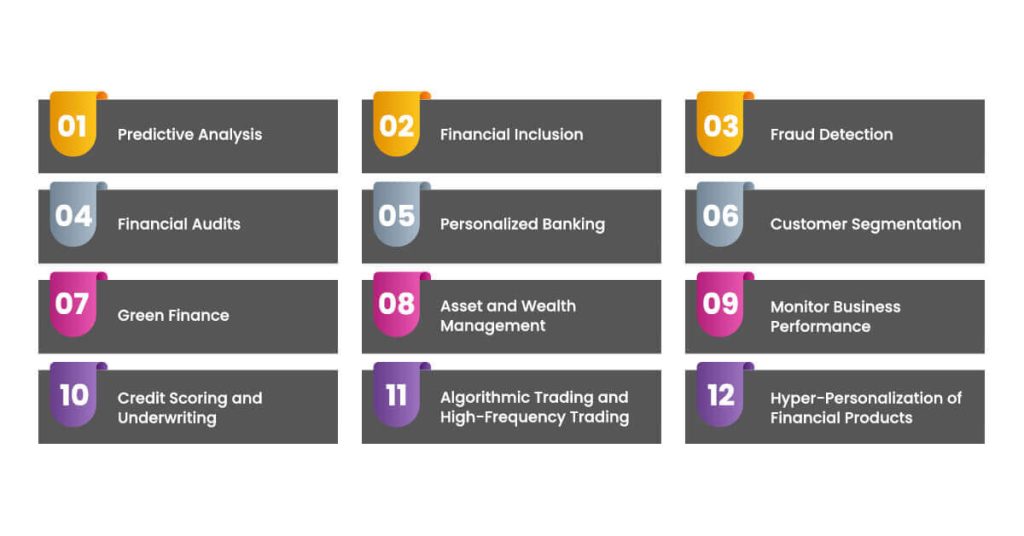Quick Summary
Financial institutions, such as banks, insurance companies, loan providers, P2P finance, micro-finance companies, etc. now use big data analytics to improve decision-making related to everyday workflows and strategic operations. Risk assessment, personalized services, liquidity management, and customer service are key areas where data analytics is used prominently in the finance industry. Data analytics radically transforms the finance industry’s traditional approach to make it more prepared for contemporary challenges.
Introduction
Financial organizations need more than mere reporting or statements. Without forward-looking insights, staying competitive and stable in the finance industry is difficult. Finance industry stakeholders (Banks, NBFCs, Insurance companies, Microfinance companies, Investment Banks, etc.) are constantly trying to prudently use data analytics for decision-making related to cash, customers, accounts, liquidity management, and even compliance.
Data analytics in finance refers to the process of examining large and complex financial datasets to uncover valuable insights, patterns, and trends that can drive strategic decision-making and improve financial performance. It combines statistical analysis, machine learning, and advanced computational techniques to extract meaningful information from various financial data sources.
Large corporations use financial data and its analysis, to meet customer expectations, upgrade their performance, build resilience to disruptions, and meet financial industry standards.
In this article, we are going to explore data analytics in finance, its benefits, and practical applications in the financial sector.
What is Data Analytics in Finance?
What is Data Analytics in Finance?

Data analytics in finance refers to the extraction and analysis of enormous, extremely large datasets that are computationally processed for pattern discovery, and financial trend recognition. Data sources include structured sources like financial databases (bank data, customer data, accounts data, loan data, etc.) and unstructured sources like social media. Financial data analysis gives insights that can lead to more strategic decision-making and the formulation of stronger business strategies.
Key Components of Financial Data Analytics
1. Big Data in Finance
Financial data analytics heavily relies on big data, which is characterized by the “Three Vs”:
- Volume: Massive amounts of financial data, ranging from terabytes to petabytes
- Variety: Diverse data types including structured (e.g., transaction records), semi-structured (e.g., financial reports), and unstructured (e.g., social media sentiment)
- Velocity: Real-time or near-real-time data processing capabilities
2. Data Sources
Financial data analytics draws from a wide range of sources, including:
- Market data (stock prices, exchange rates)
- Transaction records
- Financial statements
- Customer information
- Social media and news sentiment
- Economic indicators
3. Analytical Techniques
- Predictive modeling
- Risk assessment
- Pattern recognition
- Trend analysis
- Machine learning algorithms
Discover how data analytics can enhance decision-making, mitigate risks, and optimize financial performance.
Benefits of Using Data Analytics in Finance
Today’s financial landscape is characterized by increasing complexity and heightened demands. CFOs and their teams face mounting pressures from various fronts:
- Expectations for more effective partnering
- Calls for greater transparency from investors and stakeholders
- Persistent economic uncertainty
- An ever-evolving regulatory environment.
- Increasing complexity in financial instruments and transactions
- Pressure to optimize costs and improve operational efficiency
- Managing cash flow and liquidity in volatile markets
- Compliance with international accounting standards and tax regulations
- Managing currency fluctuations and foreign exchange risks
- Implementing advanced analytics and data-driven decision-making processes
These factors are driving finance professionals to adopt more analytical approaches to fulfilling their responsibilities. This means finance managers are now using data analytics for financial forecasting, cost management, liquidity management, business risk assessment, regulatory compliance, and tax management.
Data analytics also serves as a strategic prioritization of capital investments and ongoing performance accountability. Financial managers who effectively deploy data analytics will be better positioned to seize opportunities and maintain a competitive edge in the market.
The key benefits of data analytics in the finance industry are:
1. Improves Insights
2. Operational Cost Optimization
Data-led analytics automates most of the tasks involved in compliance, fraud detection, and risk management. Through analysis of financial data, companies can pinpoint areas of unnecessary spending, automate repetitive tasks, and allocate resources more effectively. This data-driven approach enables finance departments to reduce operational expenses. For instance, banks can study unprofitable branches or services and decide to close them.
3. Personalized CX
4. Task Automation
5. Compliance Management
Compliance with regulatory measures is ensured in the finance sector. Data analytics in finance automates the process of gathering, sorting, and reporting data. This will lower the chances of non-compliance and associated penalties. Big data in finance ensures smooth auditing since comprehensive records are kept. Moreover, data analytics helps financial institutions identify suspicious activity hence staying compliant with government regulations.
6. Competitive Edge
7. Risk Assessment
Big data analytics significantly improves risk assessment and management in financial institutions. By analyzing vast amounts of historical and real-time data, banks and investment firms can better predict and mitigate various types of risks. The financial services industry can employ analysis of extensive data sets to uncover patterns, relationships, and insights.
8. Stress Testing
Analytics tools can handle vast financial data, enabling comprehensive stress tests. AI algorithms create sophisticated models, identifying complex patterns. Generates realistic stress scenarios based on historical and current data. Data analytics helps forecast outcomes more accurately by considering multiple variables, at various levels, and identifying vulnerabilities. Stress testing helps meet complex requirements with detailed audit trails.
Use Case of Data Analytics in Finance

The application of data analytics in finance offers dynamic solutions from predictive analysis to personalized banking and fraud detection. Below are 12 major data analytics use cases in finance:
1. Predictive Analysis
Today, financial institutions are using predictive analytics in finance to predict future trends, risks, and opportunities using both historical and real-time financial data. One of its significant applications is credit risk assessment. In this, large datasets such as customer transaction histories and credit scores are used by lenders to analyze the possibility of loan defaults. This guides financial institutions in making informed decisions on whether loans should be approved or declined.
Besides credit risk forecasting, analysts make use of big data in terms of market trend forecast. Historical market data, up-to-date trends, and economic indicators are inputted in big data analytics in finance so that predictable models can be generated and can be used to provide insights about the way asset price directions are, thus making investor decisions less calculated.
2. Financial Inclusion
Data analytics promotes financial inclusion by offering valuable insights into consumer preferences, spending patterns, and transaction history. Through strategic insights, financial service providers can customize their products and services to more effectively address the varied needs of underprivileged sections of society. Utilizing data analytics technologies enables policymakers, financial institutions, and other stakeholders to collaborate in creating more inclusive and resilient financial systems.
3. Fraud Detection
Frauds are extremely challenging for the financial systems, causing billions every year. Predictive analytics and data mining techniques play a crucial role in identifying and preventing fraudulent activities like identity theft, payment fraud, and insider trading. In the first half of 2024 itself, 214,607 cases of credit card fraud, 61,672 cases of bank fraud, and 96,608 cases of loan fraud were reported to FTC (Federal Trade Commission).
Key methods for detecting potential fraud include anomaly detection, recognizing patterns, and analyzing behaviors. With the advent of fraud detection in finance, big data technologies have come to transform it. Presently, financial institutions collect all transactions and reconstruct huge datasets that can be analyzed for suspicious activities.
Big data analytics in finance creates the possibility to apply machine learning algorithms aimed at detecting irregular patterns, such as unusual spending behaviors or out-of-the-ordinary transaction locations, thus improving financial fraud analytics.
4. Financial Audits
Data analytics greatly enhances the quality and efficiency of audits. Examining extensive financial data, improves risk assessment, pinpointing high-risk areas so auditors can concentrate on essential matters.
Advanced algorithms in anomaly detection identify unusual patterns or transactions, boosting the detection of potential fraud or errors. Continuous auditing allows for real-time or near-real-time monitoring of financial activities, facilitating quicker issue identification.
Predictive analysis leverages historical data to anticipate future risks or trends, assisting in proactive risk management and audit planning. It also identifies inefficiencies in financial processes, offering insights for optimizing
5. Personalized Banking
Providing customized banking facilities is unavoidable in the present banking scenario if customer expectations have to be met. The application of data analytics in finance can analyze the behavior of the customers, comprising the transaction history and the respective social media activities. Data compiled from various sources helps banks understand their customers’ requirements for further customized loans, investment plans, and even insurance policies. Personalized banking fulfills the needs of customers and leads to successful long-term relationships that enhance client retention as well.
6. Customer Segmentation
Empower your financial team with advanced analytics to identify trends, forecast growth, and drive profitability. Get started now!
7. Green Finance
8. Asset and Wealth Management
Today, big data analytics in finance is a game-changer in finance asset and wealth management. Other than these, big data analytics also presents major benefits and provides insights into both the market and client behavior, which could lead to decisions that could be pivotal for institutions.
Another benefit of AI in financial services is the ability to enhance the management of risks through predictive analytics when determining a potential market trough. Large data analysis in detecting fraudulent activity in asset management adds further to the strengthening of security protocols.
Big data automation does the entire process, which will improve operational efficiency and cut costs for financial institutions.
9. Monitor Business Performance
It enables companies to keep track of key financial metrics like revenue and expenditures with profitability in real-time. Information data analytics in finance enables companies to compare their performance with that of competitors and industry standards. The large, diverse datasets aid financial institutions in making decisions based on data, helping them strategize for optimum overall efficiency. This further facilitates the setting of achievable goals along with the development of executable strategies to achieve them. Fintech data analytics is essential in helping firms sustain business operations improvement and performance monitoring activities that ensure competitiveness in a constantly evolving market.
10. Credit Scoring and Underwriting
Data analytics in accounting and finance has transformed credit scoring and underwriting practices. Thereby, financial institutions can rely on more expanded data sets and predictive analytics in finance for lenders so that lending bias can be reduced.
Therefore, there would be improved risk management analytics wherein lenders can operate at lower default rates with better judgment of creditworthiness at individual borrower levels. Big data further aids the financial institution in tailoring credits to the needs of individuals. It means lending should be made on an individualized basis for higher customer satisfaction.
11. Algorithmic Trading and High-Frequency Trading
Data analytics and machine learning algorithms are at the core of algorithmic trading strategies. These systems can analyze vast amounts of market data in real time, identifying trading opportunities and executing trades at speeds impossible for human traders. High-frequency trading, a subset of algorithmic trading, uses powerful computers to transact a large number of orders in fractions of a second, taking advantage of minute price discrepancies in the market.
12. Hyper-Personalization of Financial Products
Going beyond basic customer segmentation, data analytics can enable hyper-personalization of financial products and services. By analyzing a customer’s transaction history, financial goals, risk tolerance, and even social media activity, financial institutions can tailor their offerings to individual needs. This could include personalized savings plans, investment portfolios, or insurance products that adapt to the customer’s changing life circumstances.
Data Analytics in Microfinance
Analytics in microfinance offers institutions greater visibility, versatility, veracity, and velocity. Data analytics help in better risk management. Analytics can address challenges in microfinance. Credit scoring for microloans is possible using advanced analytics, even for borrowers with little credit history. Big Data and unconventional data sources can enhance the credit view of potential customers. Microfinance institutions (MFIs) can gain valuable insights into their clients’ financial behaviors, needs, and risks. Data analytics allows MFIs to analyze alternative data sources, such as mobile phone usage, utility bill payments, and social media activity, to create more accurate risk profiles.
Geospatial analytics can supplement traditional credit data, helping institutions assess creditworthiness more accurately. By leveraging these tools, microfinance organizations can make more informed decisions and better serve their target audience.
Conclusion
Advanced data analytics coupled with machine learning competencies have changed how financial institutions compete in the Industry 4.0 era. While most financial organizations hold data that is brimming with insights, they need more tools, tech, and analytics acumen to derive those insights.
This is where data analytics companies like X-Byte Analytics can help. Data analytics companies like X-Byte Analytics use sophisticated analytical techniques to help the finance industry discover subtle trends and patterns.
Experts at X-Byte Analytics develop bespoke data-driven solutions for the financial services industry.
Frequently Asked Questions
What is the role of data analytics in accounting and finance?
Data analytics can influence financial decision-making by analyzing historical financial data through statistical models and predictive analytics to ascertain trends and forecast future financial results.
What types of data are commonly used in financial analytics?
Financial analytics uses data types, including transaction data, market data, customer demographic information, social media data, and macroeconomic indicators.
How does data analytics improve risk management in finance?
Data analytics enhances risk management by providing more accurate risk assessments, (credit scoring), real-time monitoring of risk factors, and facilitating stress testing and scenario analysis.
Can data analytics help in predicting market trends?
Yes, predictive analytics models can analyze historical data, market sentiment, and various economic factors to forecast potential market trends and asset performance.
What role does artificial intelligence play in financial data analytics?
AI coupled with machine learning algorithms is critical in processing large volumes of financial data and identifying patterns. AI-based data analytics are useful for predicting with greater speed and accuracy than traditional methods.






